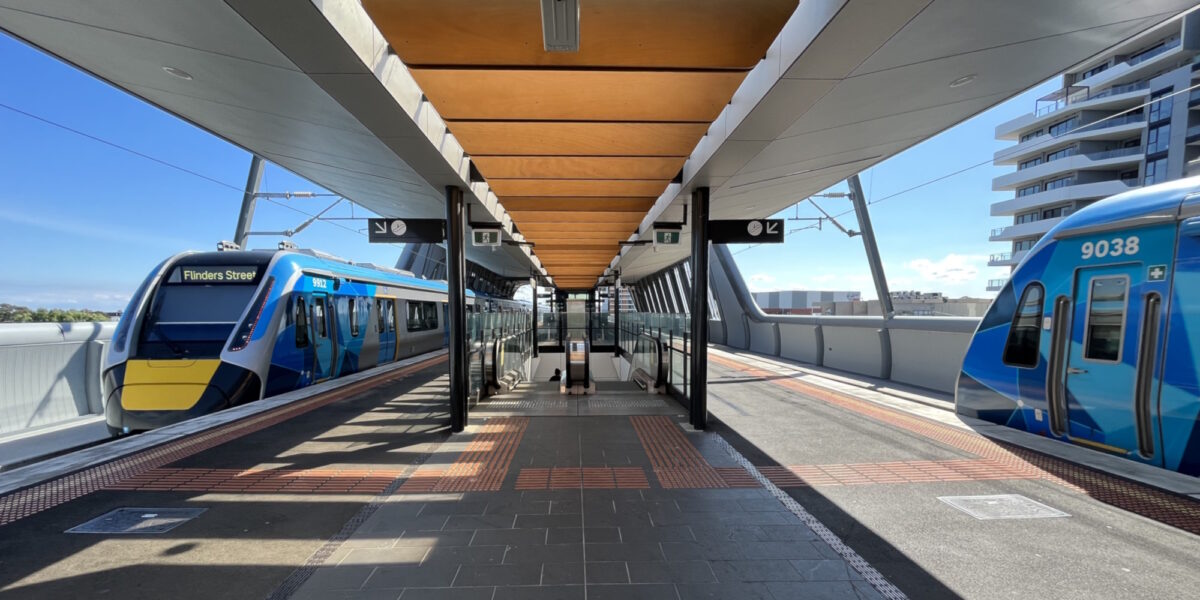Don’t tell anybody, but sometimes I drive a car.
I was at the northern end of Grange Road in Caulfield on Sunday afternoon when I saw a citybound train heading along the skyrail.
Then I saw another one.
They seemed very close together. So later I checked the dashcam footage:
The end of the first train passed the stanchion on the right hand side of the picture at 18:31:10.
The front of the second train passed the same stanchion at 18:31:46, just 36 seconds later.
The end of the second train passed at 18:31:58, so that’s two trains passing in 48 seconds.
The second train was signed Not In Service; I didn’t notice if the first one was or wasn’t, though the time matches a timetabled service, due at Caulfield at 18:32.
I know they’ve been testing the new High Capacity Signalling on this line, so this seems to have been one of those tests.
Previously the signalling on this section of the line allowed a train every 180 seconds. This was upgraded to 144 seconds during the level crossing removals – that’s 25 trains per hour, though it’s normal practice to use 80% of the theoretical capacity, so 20 tph (up from 16).
Apparently they’re planning on potentially running up to 30 trains per hour (eg every 120 seconds) by the end of this decade. The signalling itself isn’t the only limiting factor – dwell times at stations to load and unload will also come into play.
And of course signalling and other infrastructure limitations are not preventing them immediately fixing the often hopeless 20, 30, 40 minute waiting times on most lines outside peak hour – including the Cranbourne/Pakenham line where you’ll wait 30 minutes on weekend evenings.
But still, it’s great to see progress on this.

9 replies on “High Capacity Signalling in action”
Great video Daniel. That second train wouldn’t have been testing, and instead is running a regular service (in this case out of service for PMP). Surface testing has more or less now finished.
High capacity signalling has been in revenue/passenger service since July 2023. This was not a test.
Cool to see, but the HCS system only extends to Westall so it can only be used effectively for empty transfer moves to/from those sidings (unless they decide to add an inner tier at some point). If it went as far as Dandenong South Junction then it could tie in nicely with half the suburban trains using each route from there. And a similar problem out the other side, since the HCS will only go to West Footscray instead of dividing between Sunbury and [Melton/Airport].
Are there places to extend High Capacity Signalling to other lines?
At the very least, will the new Xtrap 2 trains being built right now be able to use it if it gets rolled out further?
@david there are quite a large number of services that terminate at westall currently, and this will increase when the tunnel opens. Hopefully it means more cran/pak trains can run limited express from there inwards
@John, thanks – but this was on a Sunday, so not a PM peak run. Possibly an event extra such as footy I suppose.
@Paul, eventually perhaps we’ll see HCS on other lines, but I’m not sure any are pressing right now. The bigger problem on most is lack of off-peak/evening/weekend services.
@paul, extend it to other lines? They can’t even implement it fully on 1 line, it was so expensive they blew the budget and had to only do half of what they planned and it was so complicated to implement they had to remove crossovers at Caufield just to get it to work on the half a line its on now. Plans for other lines? Maybe in 50 years.
I’ve heard rumours that HCS is going to be extended to Ginifer after (if) the Airport link is completed.
Thanks, that’s exciting! I could rant about the lack of hamonization in our signalling system and the consequences for V/Line services sharing those tracks, but I’d rather take any improvement.